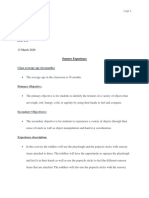0 ratings0% found this document useful (0 votes)
23 viewsCognitive-Contextual Theories
Cognitive-Contextual Theories
Uploaded by
nikita bajpaiThis document discusses several theories of intelligence proposed in the late 20th century, including Howard Gardner's theory of multiple intelligences and Sternberg's triarchic theory of intelligence. It also summarizes Mayer and Salovey's definition of emotional intelligence and discusses biological theories of intelligence that seek to understand intelligence at the neuronal level rather than through hypothetical mental constructs.
Copyright:
© All Rights Reserved
Available Formats
Download as DOCX, PDF, TXT or read online from Scribd
Cognitive-Contextual Theories
Cognitive-Contextual Theories
Uploaded by
nikita bajpai0 ratings0% found this document useful (0 votes)
23 views4 pagesThis document discusses several theories of intelligence proposed in the late 20th century, including Howard Gardner's theory of multiple intelligences and Sternberg's triarchic theory of intelligence. It also summarizes Mayer and Salovey's definition of emotional intelligence and discusses biological theories of intelligence that seek to understand intelligence at the neuronal level rather than through hypothetical mental constructs.
Original Title
Cognitive
Copyright
© © All Rights Reserved
Available Formats
DOCX, PDF, TXT or read online from Scribd
Share this document
Did you find this document useful?
Is this content inappropriate?
This document discusses several theories of intelligence proposed in the late 20th century, including Howard Gardner's theory of multiple intelligences and Sternberg's triarchic theory of intelligence. It also summarizes Mayer and Salovey's definition of emotional intelligence and discusses biological theories of intelligence that seek to understand intelligence at the neuronal level rather than through hypothetical mental constructs.
Copyright:
© All Rights Reserved
Available Formats
Download as DOCX, PDF, TXT or read online from Scribd
Download as docx, pdf, or txt
0 ratings0% found this document useful (0 votes)
23 views4 pagesCognitive-Contextual Theories
Cognitive-Contextual Theories
Uploaded by
nikita bajpaiThis document discusses several theories of intelligence proposed in the late 20th century, including Howard Gardner's theory of multiple intelligences and Sternberg's triarchic theory of intelligence. It also summarizes Mayer and Salovey's definition of emotional intelligence and discusses biological theories of intelligence that seek to understand intelligence at the neuronal level rather than through hypothetical mental constructs.
Copyright:
© All Rights Reserved
Available Formats
Download as DOCX, PDF, TXT or read online from Scribd
Download as docx, pdf, or txt
You are on page 1of 4
Cognitive-contextual theories
Cognitive-contextual theories deal with the way
that cognitive processes operate in various settings. Two of the
major theories of this type are that of the American
psychologist Howard Gardner and that of Sternberg. In 1983
Gardner challenged the assumption of a single intelligence by
proposing a theory of “multiple intelligences.” Earlier theorists had
gone so far as to contend that intelligence comprises multiple
abilities. But Gardner went one step farther, arguing that
intelligences are multiple and include, at a minimum, linguistic,
logical-mathematical, spatial, musical, bodily-kinesthetic,
interpersonal, and intrapersonal intelligence.
Some of the intelligences proposed by Gardner resembled the
abilities proposed by psychometric theorists, but others did not. For
example, the idea of a musical intelligence was relatively new, as
was the idea of a bodily-kinesthetic intelligence,
which encompassed the particular abilities of athletes and dancers.
Gardner derived his set of intelligences chiefly from studies of
cognitive processing, brain damage, exceptional individuals,
and cognition across cultures. He also speculated on the possibility
of an existential intelligence (a concern with “ultimate” issues, such
as the meaning of life), although he was unable to isolate an area of
the brain that was dedicated to the consideration of such questions.
Gardner’s research on multiple intelligences led him to claim that
most concepts of intelligence had been ethnocentric and
culturally biased but that his was universal, because it was based
upon biological and cross-cultural data as well as upon data derived
from the cognitive performance of a wide array of people.
READ MORE ON THIS TOPIC
human behaviour: The makeup of intelligence
Controversy exists over whether children can be said to differ in a unitary abstract
ability called intelligence or whether each child might...
An alternative approach that took similar account of cognition and
cultural context was Sternberg’s “triarchic” theory, which he
proposed in Beyond IQ: A Triarchic Theory of Human
Intelligence (1985). Both Gardner and Sternberg believed that
conventional notions of intelligence were too narrow; Sternberg,
however, questioned how far psychologists should go beyond
traditional concepts, suggesting that musical and bodily-kinesthetic
abilities are talents rather than intelligences because they are fairly
specific and are not prerequisites for adaptation in most cultures.
Sternberg posited three (“triarchic”) integrated and interdependent
aspects of intelligence, which are concerned, respectively, with a
person’s internal world, the external world, and experience. The
first aspect comprises the cognitive processes and representations
that form the core of all thought. The second aspect consists of the
application of these processes and representations to the external
world. The triarchic theory holds that more-intelligent persons are
not just those who can execute many cognitive processes quickly or
well; rather, their greater intelligence is reflected in knowing their
strengths and weaknesses and capitalizing upon their strengths
while compensating for their weaknesses. More-intelligent persons,
then, find a niche in which they can operate most efficiently. The
third aspect of intelligence consists of the integration of the internal
and external worlds through experience. This includes the ability to
apply previously learned information to new or wholly unrelated
situations.
Some psychologists believe that intelligence is reflected in an ability
to cope with relatively novel situations. This explains why
experience can be so important. For example, intelligence might be
measured by placing people in an unfamiliar culture and assessing
their ability to cope with the new situation. According to Sternberg,
another facet of experience that is important in evaluating
intelligence is the automatization of cognitive processing, which
occurs when a relatively novel task becomes familiar. The more a
person automatizes the tasks of daily life, the more mental
resources he will have for coping with novelty.
Other intelligences were proposed in the late 20th century. In 1990
the psychologists John Mayer and Peter Salovey defined the
term emotional intelligence as
the ability to perceive emotions, to access and generate emotions so as to assist thought, to
understand emotions and emotional knowledge, and to reflectively regulate emotions so as
to promote emotional and intellectual growth.
The four aspects identified by Mayer and Salovey involve (a)
recognizing one’s own emotions as well as the emotions of others,
(b) applying emotion appropriately to facilitate reasoning, (c)
understanding complex emotions and their influence on succeeding
emotional states, and (d) having the ability to manage one’s
emotions as well as those of others. The concept of emotional
intelligence was popularized by the psychologist and
journalist Daniel Goleman in books published from the 1990s.
Several tests developed to measure emotional intelligence have
shown modest correlations between emotional intelligence and
conventional intelligence.
Biological theories
The theories discussed above seek to understand intelligence in
terms of hypothetical mental constructs, whether they are factors,
cognitive processes, or cognitive processes in interaction with
context. Biological theories represent a radically different approach
that dispenses with mental constructs altogether. Advocates of such
theories, usually called reductionists, believe that a true
understanding of intelligence is possible only by identifying its
biological basis. Some would argue that there is no alternative
to reductionism if, in fact, the goal is to explain rather than merely
to describe behaviour. But the case is not an open-and-shut one,
especially if intelligence is viewed as something more than the mere
processing of information. As Howard Gardner pointedly asked in
the article “What We Do & Don’t Know About Learning” (2004):
Can human learning and thinking be adequately reduced to the operations of neurons, on
the one hand, or to chips of silicon, on the other? Or is something crucial missing,
something that calls for an explanation at the level of the human organism?
Analogies that compare the human brain to a computer suggest that
biological approaches to intelligence should be viewed as
complementary to, rather than as replacing, other approaches. For
example, when a person learns a new German vocabulary word, he
becomes aware of a pairing, say, between the German term Die
Farbe and the English word colour, but a trace is also laid down in
the brain that can be accessed when the information is needed.
Although relatively little is known about the biological bases of
intelligence, progress has been made on three different fronts, all
involving studies of brain operation.
You might also like
- Assessment of Learning 1 QuestionnaireDocument7 pagesAssessment of Learning 1 QuestionnaireLouise Meara Severo88% (8)
- DLL-ict-css Week #1Document16 pagesDLL-ict-css Week #1Nanette Soriano CamachoNo ratings yet
- Cognitive Psychology ReviewerDocument10 pagesCognitive Psychology ReviewerGlaiza Mae Cruz100% (2)
- Psychology Notes IntelligenceDocument7 pagesPsychology Notes IntelligenceShivaprasad HalemaniNo ratings yet
- Learn Like a Polymath: How to Teach Yourself Anything, Develop Multidisciplinary Expertise, and Become IrreplaceableFrom EverandLearn Like a Polymath: How to Teach Yourself Anything, Develop Multidisciplinary Expertise, and Become IrreplaceableRating: 4 out of 5 stars4/5 (23)
- American Revolution Lesson PlanDocument5 pagesAmerican Revolution Lesson Planapi-412552907No ratings yet
- Gardner's Theory of Multiple IntelligenceDocument5 pagesGardner's Theory of Multiple Intelligencehiral sangoiNo ratings yet
- Models 2Document24 pagesModels 2Gultekin HacibalayevaNo ratings yet
- Multiple Intelligences: José Favian Vera MorenoDocument5 pagesMultiple Intelligences: José Favian Vera Morenofabis014No ratings yet
- Psychology 101 INTELLIGENCEDocument17 pagesPsychology 101 INTELLIGENCEAEDRIELYN PICHAYNo ratings yet
- Intelligence Long DetailDocument29 pagesIntelligence Long DetailNailamumtaz JakkharNo ratings yet
- Aptitude 0 IntelligenceDocument12 pagesAptitude 0 IntelligenceAlbert MoshiNo ratings yet
- Theories of IntelligenceDocument7 pagesTheories of Intelligencenehamahesha15No ratings yet
- Howard-Jones 2009 Chapters 2 3Document39 pagesHoward-Jones 2009 Chapters 2 3prairie_fairyNo ratings yet
- IntelligenceDocument4 pagesIntelligenceAbdus SammadNo ratings yet
- Ba Ii Pii U IvDocument95 pagesBa Ii Pii U Ivsayanpanigrahi8No ratings yet
- White J 2005 Howard Gardner 1Document20 pagesWhite J 2005 Howard Gardner 1Luna MulukNo ratings yet
- BhatiaDocument4 pagesBhatia23msahr154No ratings yet
- Lecture 5. Intelligent Behaviors - Seeing My Natural AbilityDocument49 pagesLecture 5. Intelligent Behaviors - Seeing My Natural AbilityAngel PasaholNo ratings yet
- HBT Intelligence 1Document5 pagesHBT Intelligence 1appuschizoid19No ratings yet
- Intelligence and IQ: Landmark Issues and Great DebatesDocument7 pagesIntelligence and IQ: Landmark Issues and Great DebatesRaduNo ratings yet
- Sec 4 BasicDocument7 pagesSec 4 BasicBlando Irinco JonalynNo ratings yet
- Title PsychologyDocument7 pagesTitle PsychologyGaming WorldNo ratings yet
- Gardner's and Sternberg's Cognitive Learning TheoriesDocument6 pagesGardner's and Sternberg's Cognitive Learning TheoriesjulietbobbcritchlowNo ratings yet
- Document BlankDocument4 pagesDocument Blankgloirendala85No ratings yet
- Mental Ability 1 - 4Document49 pagesMental Ability 1 - 4Srinija ReddyNo ratings yet
- Intelligence PDFDocument13 pagesIntelligence PDFShaista KhattakNo ratings yet
- Draw A Person Pratical (Du2021msc0046)Document26 pagesDraw A Person Pratical (Du2021msc0046)Jeffrey Sni100% (1)
- Intelligence: Theories about Psychology, Signs, and StupidityFrom EverandIntelligence: Theories about Psychology, Signs, and StupidityNo ratings yet
- Ba 1 Sem 2 IntelligenceDocument40 pagesBa 1 Sem 2 IntelligenceKhushi Thapar100% (1)
- History of MI TheoryDocument19 pagesHistory of MI TheorygthaliagraceNo ratings yet
- Intelligence YulduzDocument25 pagesIntelligence Yulduzsobirdiyor29No ratings yet
- The Multiple IntelligenceDocument4 pagesThe Multiple IntelligenceAdorablé PerezNo ratings yet
- Lucille Britz PDFDocument18 pagesLucille Britz PDFAina AzmiNo ratings yet
- CFITDocument18 pagesCFITKriti ShettyNo ratings yet
- Development of MI TheoryDocument7 pagesDevelopment of MI TheoryCyrus EmersonNo ratings yet
- DOC-20230331-WA0009.Document13 pagesDOC-20230331-WA0009.nicholaswill75No ratings yet
- Multiple Intelligence Assessment Based o PDFDocument11 pagesMultiple Intelligence Assessment Based o PDFVryle Montemayor AmmannteNo ratings yet
- Applying Multiple IntelligencesDocument5 pagesApplying Multiple IntelligencesDaniel MartinNo ratings yet
- Cognitive: TheoriesDocument25 pagesCognitive: TheoriesSuperBkKingdomNo ratings yet
- Intelligence is one of the most talkedDocument19 pagesIntelligence is one of the most talkedFatima RehmanNo ratings yet
- Umbrella Term Mind Reason Plan Solve Problems Abstractly Language Learn Creativity Personality Character Knowledge WisdomDocument7 pagesUmbrella Term Mind Reason Plan Solve Problems Abstractly Language Learn Creativity Personality Character Knowledge WisdomAVINANDANKUMARNo ratings yet
- Is Spiritual Intelligence (SQ) or Spiritual Quotient An Intelligence? Howard Gardner's Theory of Multiple Intelligences Analyzed.Document12 pagesIs Spiritual Intelligence (SQ) or Spiritual Quotient An Intelligence? Howard Gardner's Theory of Multiple Intelligences Analyzed.PITSHOU MOLEKA BASIKABIONo ratings yet
- Intelligence (REVISED)Document23 pagesIntelligence (REVISED)ahamm ahammNo ratings yet
- Psychology Module IIDocument51 pagesPsychology Module IIMae Joy LimNo ratings yet
- Intelligence and Spiritual PerceptionDocument25 pagesIntelligence and Spiritual PerceptionMarcusTanthony0% (1)
- Multiple Intelligences - Theory and ApplicationDocument9 pagesMultiple Intelligences - Theory and ApplicationMani KalpanaNo ratings yet
- Theories of Intelligence 2Document2 pagesTheories of Intelligence 2Rivanny Citra KhaerinnisaNo ratings yet
- Different Theories of IntelligenceDocument4 pagesDifferent Theories of IntelligenceMarianne ColladoNo ratings yet
- IntelligenceDocument7 pagesIntelligenceMuhammad ShoaibNo ratings yet
- Development of MI TheoryDocument8 pagesDevelopment of MI Theorysubhash_pal_1No ratings yet
- Relationship Between Intelligence Quotient and Emotional Quotient Among AdultsDocument36 pagesRelationship Between Intelligence Quotient and Emotional Quotient Among AdultsSanskriti Bhatia 200462No ratings yet
- Chap 9 IntelligenceDocument14 pagesChap 9 Intelligenceelric4608No ratings yet
- 1 MultipleIntelligences PrintDocument8 pages1 MultipleIntelligences PrintKartika TarwatiNo ratings yet
- Intelligence and Its TheoriesDocument6 pagesIntelligence and Its TheoriesShabi PsychNo ratings yet
- IntelligenceDocument8 pagesIntelligenceRizka HartatiNo ratings yet
- Gardner The Theory of Multiple IntelligencesDocument37 pagesGardner The Theory of Multiple Intelligencesapi-301935239No ratings yet
- IntelligenceDocument27 pagesIntelligenceKj Banal100% (1)
- Identify The Different Theory of Intelligence That Influences Individual DifferencesDocument3 pagesIdentify The Different Theory of Intelligence That Influences Individual DifferencesTom-tom LunaNo ratings yet
- English 4Document2 pagesEnglish 4Shiela Fe PalenNo ratings yet
- MI in TEFLDocument14 pagesMI in TEFLDavid DíazNo ratings yet
- PDF APMDocument9 pagesPDF APMRamandeep DewanNo ratings yet
- Constant of Gravitation: Nevil Maskelyne John Henry PoyntingDocument3 pagesConstant of Gravitation: Nevil Maskelyne John Henry Poyntingnikita bajpaiNo ratings yet
- General Considerations The As A Point of Comparison Variations in Stellar SizeDocument9 pagesGeneral Considerations The As A Point of Comparison Variations in Stellar Sizenikita bajpaiNo ratings yet
- Vector 4 Gravitational Field Potential TheoryDocument3 pagesVector 4 Gravitational Field Potential Theorynikita bajpaiNo ratings yet
- Newton's Law of Gravity: Motion Moon Earth Science Force InertiaDocument4 pagesNewton's Law of Gravity: Motion Moon Earth Science Force Inertianikita bajpaiNo ratings yet
- Intellectual ExpressDocument2 pagesIntellectual Expressnikita bajpaiNo ratings yet
- Field Theories of GravitationDocument5 pagesField Theories of Gravitationnikita bajpaiNo ratings yet
- Star Constellation Orion Variable Star Magnitude Year: Betelgeuse, Also Called Alpha Orionis, Second BrightestDocument3 pagesStar Constellation Orion Variable Star Magnitude Year: Betelgeuse, Also Called Alpha Orionis, Second Brightestnikita bajpaiNo ratings yet
- The Methodology of PhysicsDocument3 pagesThe Methodology of Physicsnikita bajpaiNo ratings yet
- Fundamental Forces: and FieldsDocument2 pagesFundamental Forces: and Fieldsnikita bajpaiNo ratings yet
- Relativistic MechanicsDocument4 pagesRelativistic Mechanicsnikita bajpaiNo ratings yet
- The Scope of PhysicsDocument3 pagesThe Scope of Physicsnikita bajpaiNo ratings yet
- The Genetic RevolutionDocument1 pageThe Genetic Revolutionnikita bajpaiNo ratings yet
- Use of Tools: "A Sharp Rock", An Pebble Tool, The Most Basic of Human Stone ToolsDocument3 pagesUse of Tools: "A Sharp Rock", An Pebble Tool, The Most Basic of Human Stone Toolsnikita bajpaiNo ratings yet
- Human Evolution: Full ImageDocument2 pagesHuman Evolution: Full Imagenikita bajpaiNo ratings yet
- Neanderthal and DenisovanDocument2 pagesNeanderthal and Denisovannikita bajpaiNo ratings yet
- Human Dispersal: See Also:, ,, andDocument2 pagesHuman Dispersal: See Also:, ,, andnikita bajpaiNo ratings yet
- Group Project Peer & Self Evaluation FormDocument2 pagesGroup Project Peer & Self Evaluation FormInna Alyssa ContrerasNo ratings yet
- Tutorial 1 PE2 - Introduction and Planning 2hDocument13 pagesTutorial 1 PE2 - Introduction and Planning 2hjohnNo ratings yet
- Using Aikido Selling To Close Sales With Self-Educating BuyersDocument2 pagesUsing Aikido Selling To Close Sales With Self-Educating BuyersSankarlal ShanmugamNo ratings yet
- Aav Module 15 PPT Ucsp11Document22 pagesAav Module 15 PPT Ucsp11Prince LopezNo ratings yet
- SRP Accomplishment ReportDocument2 pagesSRP Accomplishment ReportJenny Dizon100% (1)
- Padlet RubricDocument2 pagesPadlet RubricDick PieperNo ratings yet
- ACTION RESEACRH Group10 (Inferential Statistics)Document103 pagesACTION RESEACRH Group10 (Inferential Statistics)fordmay96No ratings yet
- Module 5 - Assessment in Elementary Social StudiesDocument24 pagesModule 5 - Assessment in Elementary Social StudiesMacky AguilarNo ratings yet
- EN7V-II-a-10.1.1: EN7G-II-a-1: EN7LT-II-0-4.2Document4 pagesEN7V-II-a-10.1.1: EN7G-II-a-1: EN7LT-II-0-4.2Aristotle Tomas100% (2)
- Grade 5 Math MelcDocument2 pagesGrade 5 Math MelcHelene Grace Mamuad LachicaNo ratings yet
- Home Sci EducationDocument18 pagesHome Sci Educationsjo05100% (1)
- Grade 8 - Factoring (GCF)Document9 pagesGrade 8 - Factoring (GCF)ccmmcNo ratings yet
- Axis Bank: Deependra Kumar Investment Banking 35 Months, Oracle, Server TechnologyDocument2 pagesAxis Bank: Deependra Kumar Investment Banking 35 Months, Oracle, Server TechnologyAshok SharmaNo ratings yet
- Learning Task 1-6 Edited PDFDocument42 pagesLearning Task 1-6 Edited PDFAmielyn PusingNo ratings yet
- Nutrition and Wellness SyllabusDocument4 pagesNutrition and Wellness SyllabusdoolittleaNo ratings yet
- Frog Life Cycle - Lesson 3Document6 pagesFrog Life Cycle - Lesson 3mariamNo ratings yet
- Don Jose Ecleo Memorial Foundation College of Science and TechnologyDocument10 pagesDon Jose Ecleo Memorial Foundation College of Science and TechnologyLove Lee Tolero100% (1)
- G4 Chapter 1Document12 pagesG4 Chapter 1Jovel Daniel ProtacioNo ratings yet
- Reviewer CTPDocument4 pagesReviewer CTPCjls KthyNo ratings yet
- English For Academic and Professional Purpose1Document3 pagesEnglish For Academic and Professional Purpose1Char LayiNo ratings yet
- Ece 232 Sensory Experience 1Document6 pagesEce 232 Sensory Experience 1api-511025115No ratings yet
- Cecille - Fish Bone DiagramDocument2 pagesCecille - Fish Bone DiagramCecille MejiasNo ratings yet
- BookkeepingDocument29 pagesBookkeepingJohn Mark Estilles NudoNo ratings yet
- Required Courses For PMPCDocument2 pagesRequired Courses For PMPCapi-382122727No ratings yet
- Art Education in KeralaDocument2 pagesArt Education in KeralaJisnaNo ratings yet
- Mfat FormsDocument3 pagesMfat FormsLeand Anthony Catahumber100% (1)
- Field Study 6 Episode 1Document17 pagesField Study 6 Episode 1Shiela Marie Nazaret - MateNo ratings yet









































































































